|
|
|
Sort Order |
|
|
|
Items / Page
|
|
|
|
|
|
|
| Srl | Item |
| 1 |
ID:
138100
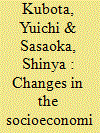

|
|
|
|
|
| Summary/Abstract |
Why do citizens support democracy under an authoritarian regime that has been waging a protracted civil war? This paper explores the attitude toward democracy expressed by urbanites who were protected by the incumbent, by employing the AsiaBarometer survey data collected during the Nepali civil war. Our empirical finding is that citizens’ favorable attitude toward democracy is fostered by economic downturn and deterioration in security. In Nepal, civil war weakened relations between the capital’s residents and rural peasants as the rebels extended their influence in the countryside and shrank the urban economic sectors. Rebel infiltration into Kathmandu furthermore posed a great threat to the residents.
|
|
|
|
|
|
|
|
|
|
|
|
|
|
|
|
| 2 |
ID:
083868
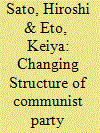

|
|
|
|
|
| Publication |
2008.
|
| Summary/Abstract |
This paper examines changes in the membership structure of the Communist Party of China during the 1990s. It concentrates on urban China to investigate the relationship between socioeconomic characteristics of the region (city) and the age, educational, and occupational structures of the regional party. The major findings are as follows. First, the development of marketization has widened opportunities for the younger generation to achieve socioeconomic success outside party membership. Second, the younger generation's incentives for joining the party have consequently been increasingly important determinants of the party's membership structure. Third, the subsequent technocratic reorganization of the urban party seems to have progressed through the conventional bureaucratic-elite path in the government and publicly owned sectors rather than through the newly emerging qualified professional-elite path
|
|
|
|
|
|
|
|
|
|
|
|
|
|
|
|
| 3 |
ID:
066839
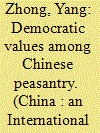

|
|
|
| 4 |
ID:
175246
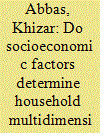

|
|
|
|
|
| Summary/Abstract |
This paper examines the socioeconomic factors of energy poverty at the household level using a dataset of 674,834 households from six South Asian countries. An adjusted multidimensional energy poverty index (MEPI) is used to measure the extent and depth of energy poverty, and a Tobit model is employed to examine the significance of socioeconomic status for multidimensional energy poverty. An ordinary least squares (OLS) regression model is compared with the results of the Tobit model, using the combined dataset and the datasets for each country separately. House size, household wealth, education, occupation (clerical, sales, or agricultural), and gender of the head of the households are significant negative socioeconomic determinants of household multidimensional energy poverty. Place of residence, house ownership status, family size, and the age of the primary breadwinner play a significant positive role in multidimensional energy poverty. These results suggest that effective policy measures for improving the socioeconomic status of households will mitigate multidimensional energy poverty. With implications for the design and implementation of policy, the evidence-based results of this study will contribute to reducing the detrimental impacts of multidimensional energy poverty nationally, regionally, and globally.
|
|
|
|
|
|
|
|
|
|
|
|
|
|
|
|
| 5 |
ID:
125079
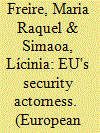

|
|
|
|
|
| Publication |
2013.
|
| Summary/Abstract |
This article addresses conceptually the European Union (EU)'s security actorness, explaining its meaning, identifying the factors that are constitutive to the concept, and analyzing whether the EU is a security actor in Georgia, through its increased presence and engagement in the country and its eventual implications for the South Caucasus. The article argues that the complementary nature of the different EU tools deployed on the ground and their comprehensive nature have contributed to the EU's consolidation as a security actor in the South Caucasus. However, and despite the successful assessments of the European Union Monitoring Mission in the context of common security and defense policy development, the mission's deployment and its contribution to regional stability are influenced to a great extent by the role and involvement of external players, in particular in this case, that of Russia
|
|
|
|
|
|
|
|
|
|
|
|
|
|
|
|
| 6 |
ID:
086235
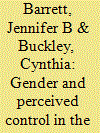

|
|
|
|
|
| Publication |
2009.
|
| Summary/Abstract |
The consequences of the socioeconomic transition for male physical health in Russia are widely documented, but much less research examines psychological well-being and mental outlook, or how these outcomes differ for men and women in Russia. Exploring gender differences in personal control, an important aspect of psychological well-being, we find that, controlling for social and economic factors, Russian women report lower levels of control than men. Gender differences in the social determinants of perceived control highlight the importance of gender roles for understanding psychological stress and inform how social expectations differentially influence men's and women's paths to well-being in Russia.
|
|
|
|
|
|
|
|
|
|
|
|
|
|
|
|
| 7 |
ID:
099103


|
|
|
|
|
| Publication |
2010.
|
| Summary/Abstract |
This paper aims to explore government preferences and cleavages in the bargaining process on the European Constitution, across the range of 25 EU member states. The study focuses on preferences concerning socioeconomic policymaking and explores whether divisions can be discerned between preferences held by actors according to locations on the left-right policy scale, actors in older as compared to newer EU states, net EU budget positions, domestic rates of support for European integration, and smaller as compared to larger states. The analysis also controls for possible external effects, such as recent domestic macroeconomic developments. Negotiations on the European Constitution are found to be determined less by general transnational left-right divisions, but cleavages according to the length of EU membership and the size of EU member states.
|
|
|
|
|
|
|
|
|
|
|
|
|
|
|
|
| 8 |
ID:
143334
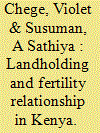

|
|
|
|
|
| Summary/Abstract |
The aim of study was to address the factors influencing landholdings and fertility among women in rural Kenya. The data used are from the 2008–2009 Kenya Demographic and Health Survey (KDHS) of a representative sample size of 6761 women, aged 15–49 years. Statistical tests are utilized to answer the research question, such as Chi-square and logistic regression and P-tests. The results show that the relationship between fertility and landholdings influences family sizes. The relationship between fertility behaviour and occupational status is found to be statistically significant with a P-value of 0.00 and χ2 of 268.24. A high proportion (68.9%) of the women had worked in the preceding reference period. The result of this study is expected to be of particular use for policy makers, planners and other interested stakeholders in population and development spheres.
|
|
|
|
|
|
|
|
|
|
|
|
|
|
|
|
| 9 |
ID:
126417


|
|
|
|
|
| Publication |
2013.
|
| Summary/Abstract |
In response to the 2011 Tunisian elections and the uncertainty surrounding Tunisia's future, we offer an empirical explanation of the election's results using socioeconomic and demographic variables. We aggregate many political analyses to describe the main parties and give insights into their strengths and weaknesses. We also examine common misconceptions advanced during the elections. Finally, we include a proposed electoral map that could be used by politicians to plan their future political strategies.
|
|
|
|
|
|
|
|
|
|
|
|
|
|
|
|
| 10 |
ID:
137367
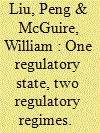

|
|
|
|
|
| Summary/Abstract |
As China proceeds with a process of urbanization unprecedented in human history, it maintains an urban-biased governance regime in many areas, including food safety regulation. Using secondary data and interviews with officials from the Changping district in Beijing, this article systematically defines the main characteristics of China's dual food safety regulation regimes, highlighting differences between urban and rural areas in four dimensions: policy structure, funding source, staff structure and resource allocation. This article also provides an explanatory framework to understand this dual regime's development and persistence from a neo-institutionalism perspective. Three main explanatory variables are advanced: historical legacy, dual incentive structures, and dual economic and industrial patterns. While China's urbanization process and governance structure, including the food safety regulatory regime, are not complete by Western standards, we emphasize this problem is best understood by examining China's unique socioeconomic and cultural context.
|
|
|
|
|
|
|
|
|
|
|
|
|
|
|
|
| 11 |
ID:
109546
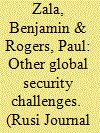

|
|
|
| 12 |
ID:
120438


|
|
|
|
|
| Publication |
2013.
|
| Summary/Abstract |
The concept of Emancipation has become increasingly important in security studies in recent years but how well does the idea travel outside of the Western context in which it was conceived and into the Middle East? This article examines Hizbollah's four main identities: religious, resistance, socioeconomic, and as allies/proxies of Iran and asks to what extent this key regional non-state actor sees itself as an emancipatory agent in its own terms and how this differs from the Emancipatory ideal of Critical Security Studies (CSS). Does Hizbollah's current makeup offer enough scope to pursue Emancipation in line with the CSS project? Since the precept of Jihad offers Muslims a theological justification to engage in a holy struggle for a moral, spiritual, or political goal, seemingly Hizbollah is uniquely positioned to offer the prospect of Emancipation for the traditionally downtrodden Shi'a citizens of Lebanon, but does their Islamic faith and their aim of adherence to the Islamic way of life which they interpret from the Qur'an and Sunnah proscribe their credentials as truly Emancipatory actors? The article uses this analysis to examine the extent to which the commitment to universal Emancipation, found in CSS, is reconcilable with its Western-orientated foundation when applied in a Middle Eastern context.
|
|
|
|
|
|
|
|
|
|
|
|
|
|
|
|
| 13 |
ID:
078842
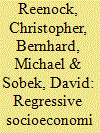

|
|
|
|
|
| Publication |
2007.
|
| Summary/Abstract |
Many scholars have argued that unequal socioeconomic distribution constitutes a threat to democratic survival. However, the evidence in support of this claim has been contradictory. We argue that this inconsistency derives from the literature's assumption that income inequality will adequately reflect the conditions under which demands for radical redistribution will emerge and trigger antidemocratic elite reactions. We argue instead that when developmental context is taken into consideration, absolute forms of distribution, like basic needs deprivation, are better indicators of these conditions. When needs deprivation exists in the face of enhanced economic development, citizens will not only notice deprivation more readily, but also, given the greater social surplus, deem it more unacceptable, provoking radical demands for redistributive justice. This combination of development and continuing basic needs shortfalls, a condition that we refer to as regressive socioeconomic distribution, will threaten democratic survival. Using event history analysis on a sample composed of all democracies from 1961 to 1995, we confirm that regressive socioeconomic distribution increases the risk of breakdown.
|
|
|
|
|
|
|
|
|
|
|
|
|
|
|
|
| 14 |
ID:
149184
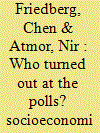

|
|
|
|
|
| Summary/Abstract |
2015 was an important year in the history of Israeli general elections: voter turnout rose by 4.5% compared to the 2013 elections, exceeding the 70% threshold after 16 years of low rates. Interesting as this may be, a more interesting question is: who were the voters turning out at the polls in the 2015 elections (and where)? When looking at the election results from the municipal perspective, we can see a variance between localities: turnouts were high in some places while in others they were low. In order to explain the differences in voting patterns among localities we conducted an ecological analysis of the aggregated data regarding participation rates in 196 municipalities in Israel, as well as their social and economic characteristics. The most salient finding is that political participation in peripheral and low socioeconomic localities was lower than in the country’s geographical and generally more economically robust centre.
|
|
|
|
|
|
|
|
|
|
|
|
|
|
|
|
| 15 |
ID:
170596
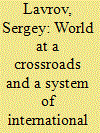

|
|
|
|
|
| Summary/Abstract |
Next year we will celebrate two great and interconnected anniversaries—the 75th Anniversary of the Victory in the Great Patriotic and Second World Wars, and the establishment of the UN. Reflecting on the spiritual and moral significance of these landmark events, one needs to bear in mind the enormous political meaning of the victory that ended one of the most brutal wars in the history of mankind
|
|
|
|
|
|
|
|
|
|
|
|
|
|
|
|
| 16 |
ID:
095165
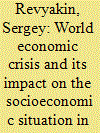

|
|
|
|
|
| Publication |
2009.
|
| Summary/Abstract |
The world financial crisis, which began with the collapse of the U.S. credit pyramid, is known to be the biggest crisis since the Great Depression.
The first signs of the crisis appeared in the U.S. mortgage market in 2006 (housing loans were not being repaid), and shortly afterwards this market collapsed, triggering a global liquidity crisis. Housing prices in the U.S. plummeted, investments in housing construction fell, and the liquidity of the mortgage derivatives market began to decline. All of this took place against the background of a jump in credit spreads in money markets; the stocks of international companies plunged, and stock indexes fell significantly due to the bankruptcy of major financial institutions, primarily investment banks.
|
|
|
|
|
|
|
|
|
|
|
|
|
|
|
|
|
|
|
|
|